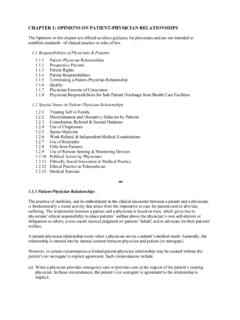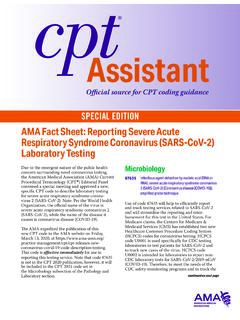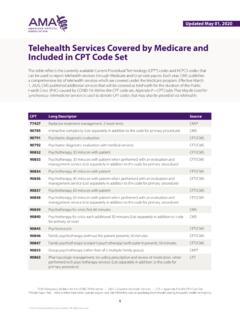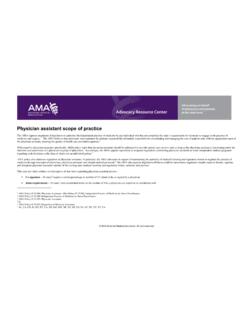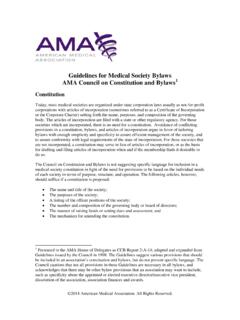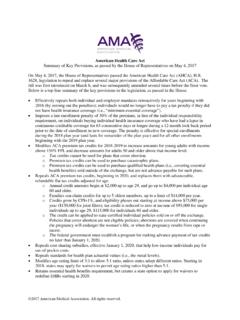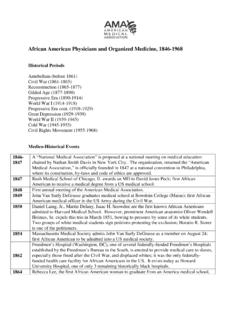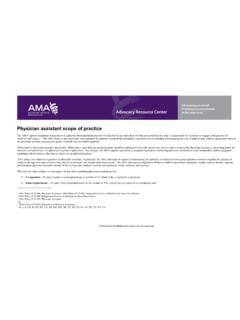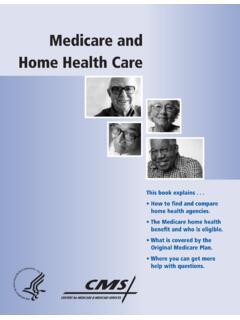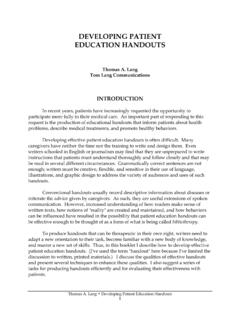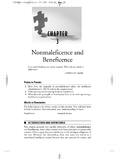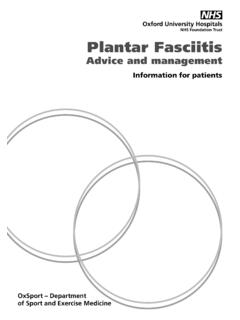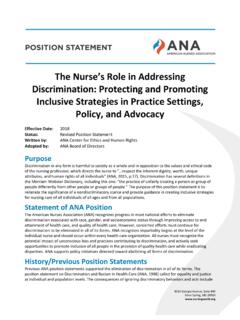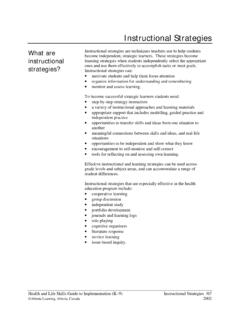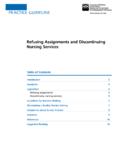Transcription of Guide to Surprise Billing Provisions in the Consolidation ...
1 1 2021 American Medical Association. All rights reserved. Guide to Surprise Billing Provisions in the Consolidated Appropriations Act 2021 The Consolidated Appropriations Act COVID-19 relief bill signed into law on December 27, 2020 is a comprehensive, $ trillion legislative package that includes COVID-19 related relief for physicians and provides funding for health care related government operations through the end of fiscal year 2021. This new law includes the No Surprises Act (the Act), which allows for price transparency, provider directories, and patient financial protections that impact health plans, physicians1, facilities, and other non-MD/DO licensed health care professionals effective January 1, 2022.
2 The following Guide details the important Provisions of the Act. Patient protections ( Surprise Billing ) Scope of Protections The Act protects patients from Surprise medical bills when they receive unanticipated out-of-network care in emergency and nonemergency settings. Specifically, the law applies to out-of-network providers (see footnote 1) and facilities delivering emergency care and out-of-network providers delivering emergency and nonemergency care at in-network facilities. The law also protects patients from Surprise bills from out-of-network air ambulance services. Cost-S haring patients are only responsible for cost-sharing amounts that would be their responsibility if care had been provided in-network.
3 Additionally, providers will be barred from holding patients liable for higher amounts. The patient s cost-sharing is based on the recognized Impact on Uninsured The Act requires the Secretary of Health and Human Services (HHS) to establish an Independent Dispute Resolution (IDR) process by January 1, 2022 for circumstances in which an uninsured patient s bill is substantially in excess of a good faith estimate. For the purposes of the Act, uninsured means that a patient does not have benefits for the item or service. 1 The statute s use of the term provider includes physicians and other non-MD/DO licensed health care professionals. 2 The recognized amount is the: (1) Amount under specified state law (as applied to plans regulated by state law); (2) Qualifying payment amount; or (3) If the state has an All-payer model agreement, then the amount the state approves.
4 The qualifying payment amount in 2022 is the median of the contracted ( , in-network) rates as determined by all plans of a plan sponsor or all coverage offered by the health insurance issuer in the same insurance market on 1/31/19, increased by the consumer price index for all urban consumers (CPIU). The qualifying payment amount in 2023 is: (1) Based on previous year + CPIU; (2) For new plans, the HHS Secretary determines methodology; or (3) If there is insufficient info to determine, the plan will use database allowed by Secretary of HHS. 2 2021 American Medical Association. All rights reserved. Pr ocess for Resolving Payment There must be an initial payment (determined by the plan) directly from the plan to the provider, or a notice of a denial, within 30-days after the provider transmits the bill to the plan.
5 If the provider is not satisfied with the payment from the plan, they may begin a 30-day open negotiation period. If an agreement cannot be reached in the open negotiation period, the plan or provider has four calendar days to notify the other party and Secretary of HHS that they are initiating an Independent Dispute Resolution process. Independent Dispute Resolution (IDR) IDR Process The IDR process establishes an arbitration procedure that allows independent review of provider-plan disputes. Within three days following the date the IDR process is initiated, the provider and plan must jointly select a certified IDR entity. IDR is initiated when the provider or plan submits a notification to the other party and Secretary of HHS.
6 The parties may continue negotiating during the 30-day IDR process and may agree on a payment amount before the end of the IDR process (in such case both parties will share the cost to compensate the IDR entity). Within 10-days of selecting the IDR entity, the parties must submit final offers, information requested by IDR entity, and additional information (subject to certain exceptions) the parties believe are relevant to their offers. The party whose offer was not chosen by the IDR entity pays the costs of IDR. Payment for the disputed services must be made to the provider within 30-days of the IDR entity s determination. Batching is allowed for claims submitted within a 30-day period that meet the following criteria: Services furnished by same provider or facility.
7 Services provided to patients under the same plan. Services are for treatment of similar conditions. The party that initiated IDR cannot initiate a new IDR process with the same party and for same services for 90 days. However, once the 90-day period is up, the party may submit (appropriately batched) claims from that 90-day period to IDR. Factors C onsidered by the IDR Entity Within 30 days, the IDR entity selects one of the offers submitted and must consider: Offers by both parties; and Qualifying payment amount (see footnote 2) for the same service in the same geographic region. The IDR entity can also consider the following factors: Training, experience, quality, and outcomes measurements; Market shares of parties; Acuity of patients /complexity of cases; Teaching status, case mix, scope of services of facility; and Good faith efforts by parties to contract and contracting rate history from last four years.
8 The IDR entity cannot consider: Usual and customary rates; Billed charges; and Payment rates by public payors, including Medicare, Medicaid, CHIP, and Tricare. 3 2021 American Medical Association. All rights reserved. Notice and Consent Requirements for Providers Out-of-network providers providing scheduled services at in-network facilities may not bill a patient more than the in-network cost-sharing requirements or balance bill the patient unless notice and consent requirements are met. Such notice and consent requirements are met if: The patient is provided written notice and consent 72 hours in advance of appointment. Documents provided to patients must include a good faith estimate of the costs of the services (the language specifies this advanced notice does not constitute a contract).
9 patients must also receive a list of in-network providers at the facility and information regarding medical care management, such as prior authorization. At in-network facilities, the notice and consent exception does not apply to out-of-network providers of radiology, pathology, emergency, anesthesiology, diagnostic, and neonatal services; or to assistant surgeons, hospitalists, intensivists, and providers offering services when no other in-network provider is available. The Secretary of HHS may apply civil monetary penalties of up to $10,000 but may provide a hardship exemption or waive the penalties for providers and facilities that did not knowingly violate the requirements laid out under the statute.
10 Provider Directories effective January 1, 2022, health plans must ensure provider directories are current and accurate, with regular verification of provider contract status and updates required at least once every 90 days. Providers are required to submit regular updates to group health plans and insurers to assist with their verification and update process, including notice of material changes to their provider directory information. The database of provider directories must be updated within two business days of the health plan receiving such data. Health plans must also respond to enrollees about a provider s network status within one business day of a request and establish a database of in-network providers.
